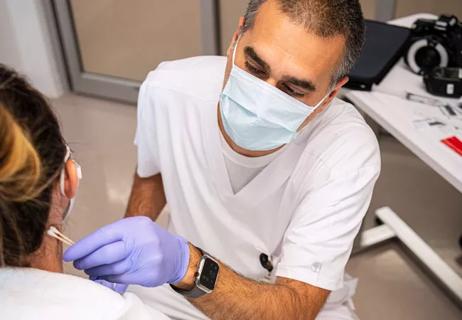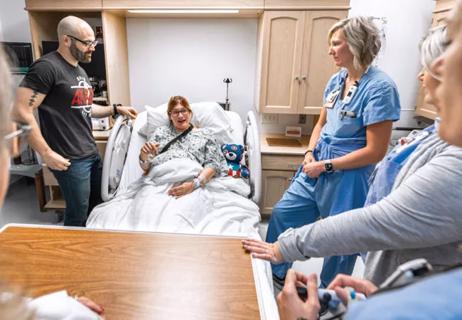ICU initiative decreases alarm usage

Critical alarm systems are vital in hospitals, warning caregivers of potential patient problems. However, if not appropriately managed, these alarms can actually compromise patient safety. Among the issues in some hospital units, such as ICUs, is the overabundance of alarm signals, which can cause nurses and physicians to become desensitized to the resulting noise and displayed information.
Cleveland Clinic is a non-profit academic medical center. Advertising on our site helps support our mission. We do not endorse non-Cleveland Clinic products or services. Policy
In 2013, Cleveland Clinic began an alarm reduction initiative led by Aaron Hamilton, MD, from Quality and Patient Safety, and Shannon Pengel, MSN, RN, NE-BC, Clinical Nursing Director of Cleveland Clinic’s Sydell and Arnold Miller Family Heart & Vascular Institute and Critical Care. The goals were to analyze adult alarm default parameters and establish safe thresholds for monitoring cardiac rhythms and other hemodynamic values. After completing careful analysis for current alarm data, changes were implemented that significantly reduced the number of alarms sounding on nursing units. This work then translated into an ICU alarm reduction initiative begun last year.
“The ICU initiative stands to better patient safety while also improving the caregivers’ working environment by decreasing sensory overload through exposure to an excessive number of alarms, which can lead to desensitization and result in missed alarms,” says Anita J. White, MSN, RN, APRN-BC, CCRN, a clinical nurse specialist in Medical Intensive Care at Cleveland Clinic and chair of the ICU Alarm Committee on Main Campus.
Alarm safety – and its propensity to lead to alarm fatigue – is a hot topic in the healthcare industry. The nonprofit organization ECRI Institute identifies critical alarm hazards, including inadequate alarm configuration policies and practices, as the No. 1 technology hazard lurking in hospitals in its 2015 list of Top 10 Health Technology Hazards. The Joint Commission recognizes the problem: In 2014, it implemented Phase 1 of a new National Patient Safety Goal on clinical alarm safety for hospitals. Beginning last January, hospitals were required to establish alarms as an organization priority and identify the most important alarms to manage based on their own internal situations.
While technology advancements have led to many great strides in the betterment of healthcare, they have also caused more ‘bells and whistles,’ which usually result in an alarm. There are several ways that hospitals can combat the problem. A 2014 article authored by B.J. Drew et al in PLOS ONE, a peer-reviewed, open access online publication, found that by critically analyzing the types of alarms in units, device manufacturers could make a few changes that would decrease ‘non-actionable’ alarms. Another solution involves educating caregivers: If they have better knowledge of the sometimes overlapping device technology, then organizations can make better choices about which alarms to activate.
When Cleveland Clinic launched its ICU alarm reduction initiative, the healthcare system formed an interdisciplinary team to help standardize processes surrounding alarms. The team targeted non-actionable alarms – or nuisance alarms – and labeled them as ones that require no therapeutic intervention to decrease the episodes of alarms.
One of the steps taken by the team was to standardize the heart rate alarm high and low parameters as well as blood oxygen saturation (SpO2) high and low parameters. The team analyzed alarms using a system developed by Marc Petre, PhD, Executive Director of Clinical Engineering at Cleveland Clinic, to review data pre- and post-change. During that analysis, they discovered duplications in device alarms. Further alarm analysis is now part of an Institutional Review Board study.
Nurses are integral to reducing alarms. For instance, they can individualize alarm parameters to each patient’s condition and ensure that ECG electrodes are changed at the frequency recommended by manufacturers’ instructions.
“Nurses play a key role in identifying necessary alarms and those alarms that are non-actionable,” says White, who is a member of the National Association of Clinical Nurse Specialist’s Alarm Task Force, which has recently been acknowledged in the Agency for Healthcare Research and Quality’s weekly journal. “As we further reduce non-actionable alarms, we subsequently emphasize actionable alarms. Alarms with meaning and value will then become more apparent.”
Cleveland Clinic’s ICU alarm reduction program is working. Says White, “This approach, coupled with detailed data analysis and interdisciplinary team oversight, has led to a 7 percent decrease in alarms per patient per day in our intensive care units.”

Nurses play pivotal role in patients’ ability to recover in the comfort of their own homes

Advocating for patient safety is imperative in fast-paced surgical settings

Advice for those pursuing a WOC nursing career

Redesigned protocols enhance infection-prevention measures

Longevity in healthcare, personal experiences may provide caregivers with false sense of confidence

Specialized team prioritizes trauma-informed care and evidence collection

Collaborative approach leans on expertise of nurses

TeamBirth aims to improve outcomes by facilitating collaboration between patients and caregivers